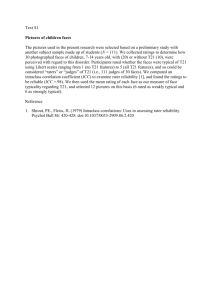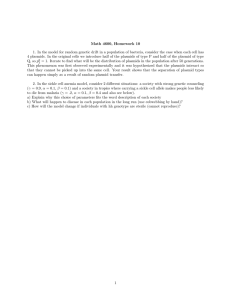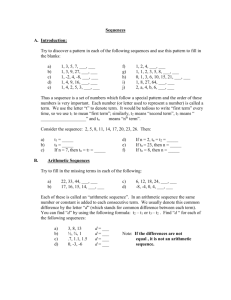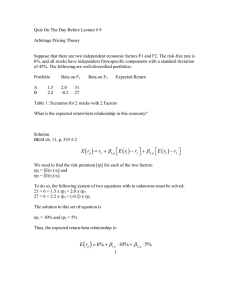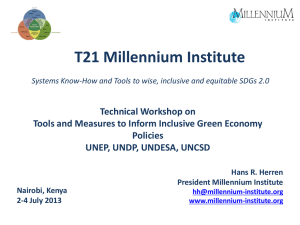NOTES Translocatable Phenylmercuric Bacteria
advertisement
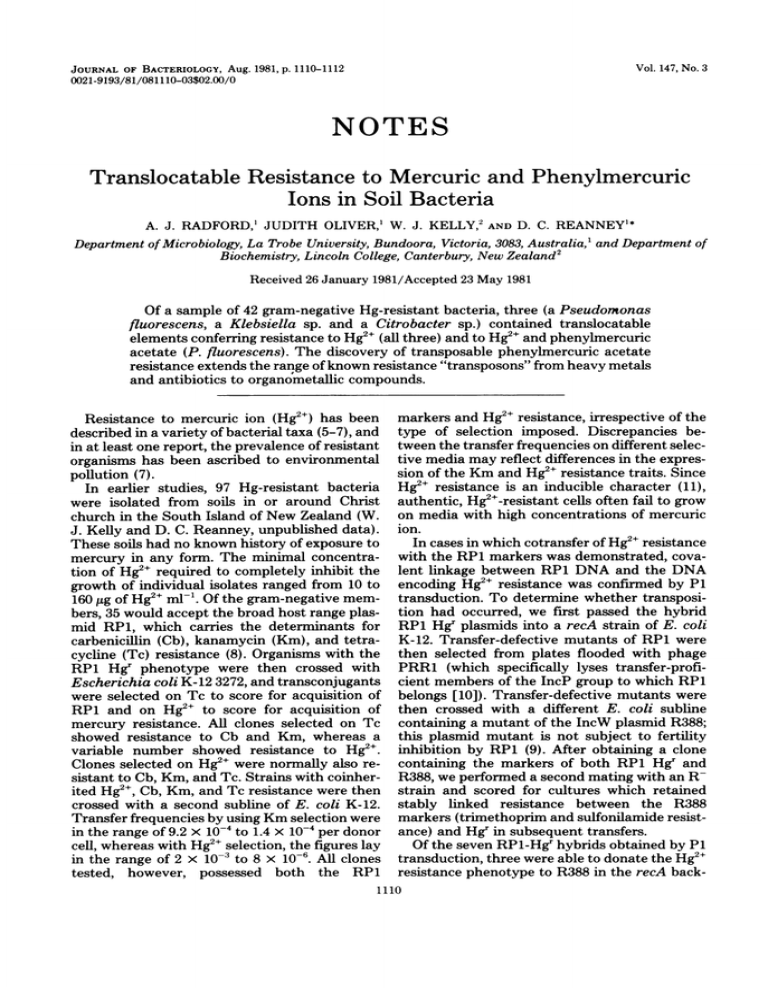
Vol. 147, No. 3 JOURNAL OF BACTERIOLOGY, Aug. 1981, p. 1110-1112 0021-9193/81/0811 10-03$02.00/0 NOTES Translocatable Resistance to Mercuric and Phenylmercuric Ions in Soil Bacteria A. J. RADFORD,' JUDITH OLIVER,' W. J. KELLY,2 AND D. C. REANNEYI* Department of Microbiology, La Trobe University, Bundoora, Victoria, 3083, Australia,' and Department of Biochemistry, Lincoln College, Canterbury, New Zealand2 Received 26 January 1981/Accepted 23 May 1981 Of a sample of 42 gram-negative Hg-resistant bacteria, three (a Pseudomonas fluorescens, a Klebsiella sp. and a Citrobacter sp.) contained translocatable elements conferring resistance to Hg2" (all three) and to Hg2' and phenylmercuric acetate (P. fluorescens). The discovery of transposable phenylmercuric acetate resistance extends the range of known resistance "transposons" from heavy metals and antibiotics to organometallic compounds. Resistance to mercuric ion (Hg2+) has been described in a variety of bacterial taxa (5-7), and in at least one report, the prevalence of resistant organisms has been ascribed to environmental pollution (7). In earlier studies, 97 Hg-resistant bacteria were isolated from soils in or around Christ church in the South Island of New Zealand (W. J. Kelly and D. C. Reanney, unpublished data). These soils had no known history of exposure to mercury in any form. The minimal concentration of Hg2e required to completely inhibit the growth of individual isolates ranged from 10 to 160 jig of Hg2+ ml-1. Of the gram-negative members, 35 would accept the broad host range plasmid RP1, which carries the determinants for carbenicillin (Cb), kanamycin (Km), and tetracycline (Tc) resistance (8). Organisms with the RP1 Hgr phenotype were then crossed with Escherichia coli K-12 3272, and transconjugants were selected on Tc to score for acquisition of RP1 and on Hg2+ to score for acquisition of mercury resistance. All clones selected on Tc showed resistance to Cb and Km, whereas a variable number showed resistance to Hg2e. Clones selected on Hg2+ were normally also resistant to Cb, Km, and Tc. Strains with coinherited Hg2+, Cb, Km, and Tc resistance were then crossed with a second subline of E. coli K-12. Transfer frequencies by using Km selection were in the range of 9.2 x 10-4 to 1.4 x 10-4 per donor cell, whereas with Hg2+ selection, the figures lay in the range of 2 x 10-3 to 8 x 10-6. All clones tested, however, possessed both the RP1 markers and Hg2+ resistance, irrespective of the type of selection imposed. Discrepancies between the transfer frequencies on different selective media may reflect differences in the expression of the Km and Hg2+ resistance traits. Since Hg2+ resistance is an inducible character (11), authentic, Hg2+-resistant cells often fail to grow on media with high concentrations of mercuric ion. In cases in which cotransfer of Hg2+ resistance with the RP1 markers was demonstrated, covalent linkage between RP1 DNA and the DNA encoding Hg2+ resistance was confirmed by P1 transduction. To determine whether transposition had occurred, we first passed the hybrid RP1 Hgr plasmids into a recA strain of E. coli K-12. Transfer-defective mutants of RP1 were then selected from plates flooded with phage PRR1 (which specifically lyses transfer-proficient members of the IncP group to which RP1 belongs [10]). Transfer-defective mutants were then crossed with a different E. coli subline containing a mutant of the IncW plasmid R388; this plasmid mutant is not subject to fertility inhibition by RP1 (9). After obtaining a clone containing the markers of both RP1 Hgr and R388, we performed a second mating with an Rstrain and scored for cultures which retained stably linked resistance between the R388 markers (trimethoprim and sulfonilamide resistance) and Hgr in subsequent transfers. Of the seven RP1-Hgr hybrids obtained by P1 transduction, three were able to donate the Hg2+ resistance phenotype to R388 in the recA back- 1110 NOTES 1111 VOL. 147, 1981 ground. The original soil donors of the translocatable DNA units were a Pseudomonas fluorescens, which was resistant to both Hg2+ and to the organomercurial, phenylmercuric acetate (PMA), and a Klebsiella sp. and a Citrobacter sp., both of which were resistant to Hg2+ but not to PMA. The frequency of recA-independent movement in all three cases was approximately 1% at 370C under the experimental conditions used. Analysis on agarose gels showed significant differences in size between plasmids extracted from clones with and without the PMAr Hgr phenotype (Fig. 1D) and between plasmids extracted from clones with and without the Hgr phenotype (data not shown). Digestion of the hybrid R388 PMAr Hgr molecule with the restriction nuclease HindIII showed that the en- A BC R PIPMArHgr & R1-163 RP1I R388-PM4Ar0 Hgr R3880 -2 7Md. -14Md. -1l2Md. FIG. 1. Agarose gel electrophoresis of intact and endonuclease-digested plasmid DNA. DNA was obtained by cesium chloride-ethidium bromide density gradient centrifugation of DNA precipitated from cleared cell lysates (4). Electrophoresis was for 3 (A, B, and C) and 5 h (D) in Tris-borate-buffered 0.6% agarose. (A) RP1 PMA' Hg' digested with HindIII; (B) R388 PMA' Hg' digested with HindIII. Fragments common to both (A) and (B) are marked by arrows. (C) A DNA digested with HindIII; (D) intact R388 (21.5 Md), R388 PMA' Hg' (-27.5 Md), RP1 (38 Md), RP1 PMA' Hgr (-44 Md), and R1-16 DNA (52 Md). zyme cut the hybrid molecule four times, whereas the original R388 plasmid was cut only once. Of the three additional bands obtained from the R388 PMAr Hgr DNA, two were obtained from HindII digests of the hybrid form of RP1 PMAr Hgr, confirming the presence of identical or similar inserted nucleotide sequences in both plasmids (Fig. 1A and B). An identical result was obtained with DNA extracted from a transconjugant from a second RP1 PMAr Hgr x R388 cross, suggesting that the same sequences had "transposed" between the two plasmids. Similar studies have demonstrated the existence of inserted sequences in the two cases of Hg resistance. We estimate the size of the insertion conferring joint PMA-Hg resistance as about 6 megadaltons (Md) and that of the insertions conferring Hg resistance alone as about 5 Md. The elements described in this paper display the properties expected of "transposons." We cannot formally exclude the possibility that the original resistance genes were located on small, presumably nonconjugative plasmids which formed cointegrates with RP1 by some form of recA-independent recombination. However, repeated gel analyses of DNA extracted from the original P. fluorescens strain revealed only one faint plasmid band between the origin and the position of chromosomal DNA. This plasmid was much too big to account for the estimated size differences between RP1 or R388 DNA with and without the inserted module. No plasmids were detected in the original Klebsiella and Citrobacter sp. As our extraction techniques did not enrich for very large plasmids, we are unable to specify the replicons which are the source of the PMAr Hgr and Hgr genes, but our data clearly favor a transposition model over a cointegration model. The transposons described in this paper have been assigned the following reference codes: the PMAr Hgr transposon, Tn3401, the Hg' transposon from the Citrobacter sp., Tn3402, and the transposon from the Klebsiella sp., Tn3403. These three transposons have been compared with each other and with the original Hgr transposon Tn501 (12) by digesting RP1 containing each of the transposons in turn with a common battery of restriction nucleases (EcoRI, BamHI, and HindIII). The restriction maps for Tn3402 and Tn3403 were identical. However, the maps for these two transposons differed both from Tn3401 and from Tn5OI. It appears that the Hgr phenotype common to all four transposons tested does not result from a single, conserved nucleotide sequence. Transposable resistance to mercuric ion but not to PMA has been reported (3, 12, 13). The J. BACTERIOL. 1112 NOTES discovery of a PMA resistance transposon extends the range of known resistance transposons from heavy metals and antibiotics to organometallic compounds. Although about 16 clearly different transpositional elements have been described in bacteria (2), most known resistance units have come from organisms of clinical origin. Our data and those of Friello and Chakrabarty (3) suggest that soil may be an important source or reservoir of translocatable elements encoding resistance to heavy metals, as has already been suggested for resistance to antibiotics (1). We cannot explain why transposable PMA' Hgr resistance should be readily detectable in soils evidently not subject to direct mercury selection. We note, however, that for many years, mercury was extensively used to extract alluvial gold in various parts of the South Island of New Zealand. The diffusion of Hg2+ resistance from bacteria in such highly contaminated areas to those in relatively uncontaminated soils may have been aided by the presence or development of transposable mercury resistance genes. LITERATURE CITED 1. Courvalin, P., B. Weisblum, and J. Davies. 1977. Aminoglycoside-modifying enzyme of an antibiotic-producing bacterium acts as a determinant of antibiotic resistance in Escherichia coli. Proc. Natl. Acad. Sci. U.S.A. 74:999-1003. 2. Davey, R. B., and D. C. Reanney. 1980. Extrachromosomal genetic elements and the adaptive evolution of bacteria. Evol. Biol. 13:113-147. 3. Friello, D. A., and A. M. Chakrabarty. 1980. Transposable mercury resistance in Pseudomonas putida, p. 249-260. In C. Stuttard and K. R. Rozee (ed.), Plasmids 4. 5. 6. 7. 8. 9. 10. 11. 12. 13. and transposons: environmental effects and maintenance mechanisms. Academic Press, Inc., New York. Humphreys, G. O., G. A. Willshaw, and E. S. Anderson. 1975. A simple method for the preparation of large quantities of pure plasmid DNA. Biochim. Biophys. Acta 383:457-463. Nakahara, H., T. Ishikawa, Y. Sarai, L. Kondo, H. Kozukue, and S. Mitauhashi. 1977. Mercury resistance and R plasmids in Escherichia coli isolated from clinical lesions in Japan. Antimicrob. Agents Chemother. 11:999-1003. Nakahara, H., T. Ishikawa, Y. Sarai, I. Kondo, H. Kozukue, and S. Silver. 1977. Linkage of mercury, cadmium, and arsenate and drug resistance in clinical isolates of Pseudomonas aeruginosa. Appl. Environ. Microbiol. 33:975-976. Nakahara, H., T. Ishikawa, Y. Sarai, I. Kondo, and S. Mitsuhashi. 1977. Frequency of heavy-metal resistance in bacteria from inpatients in Japan. Nature (London) 266:165-167. Olsen, R. H., and P. Shipley. 1973. Host range and properties of the Pseudomonas aeruginosa R-factor R1822. J. Bacteriol. 113:772-780. Olsen, R. H., and P. Shipley. 1975. RP1 properties and fertility inhibition among P, N, W, and X incompatibility group plasmids. J. Bacteriol. 123:28-35. Olsen, R. H., and D. D. Thomas. 1973. Characteristics and purification of PRR1, an RNA phage specific for the broad host range Pseudomonas R1822 drug resistance plasmid. J. Virol. 12:1560-1567. Schottel, J., A. Mandel, D. Clark, S. Silver, and R. W. Hedges. 1974. Volatilisation of mercury and organomercurials determined by inducible R-factor systems in enteric bacteria. Nature (London) 251:335-337. Stanisich, V. A., P. M. Bennett, and M. H. Richmond. 1977. Characterization of a tranalocation unit encoding resistance to mercuric ions that occurs on a nonconjugative plasmid in Pseudomonas aeruginosa. J. Bacteriol. 129:1227-1233. Summers, A. O., R. B. Weiss, and G. A. Jacoby. 1980. Transposition of mercury resistance from a transferable R-plasmid of Escherichia coli. Plasmid 3:35-47.
